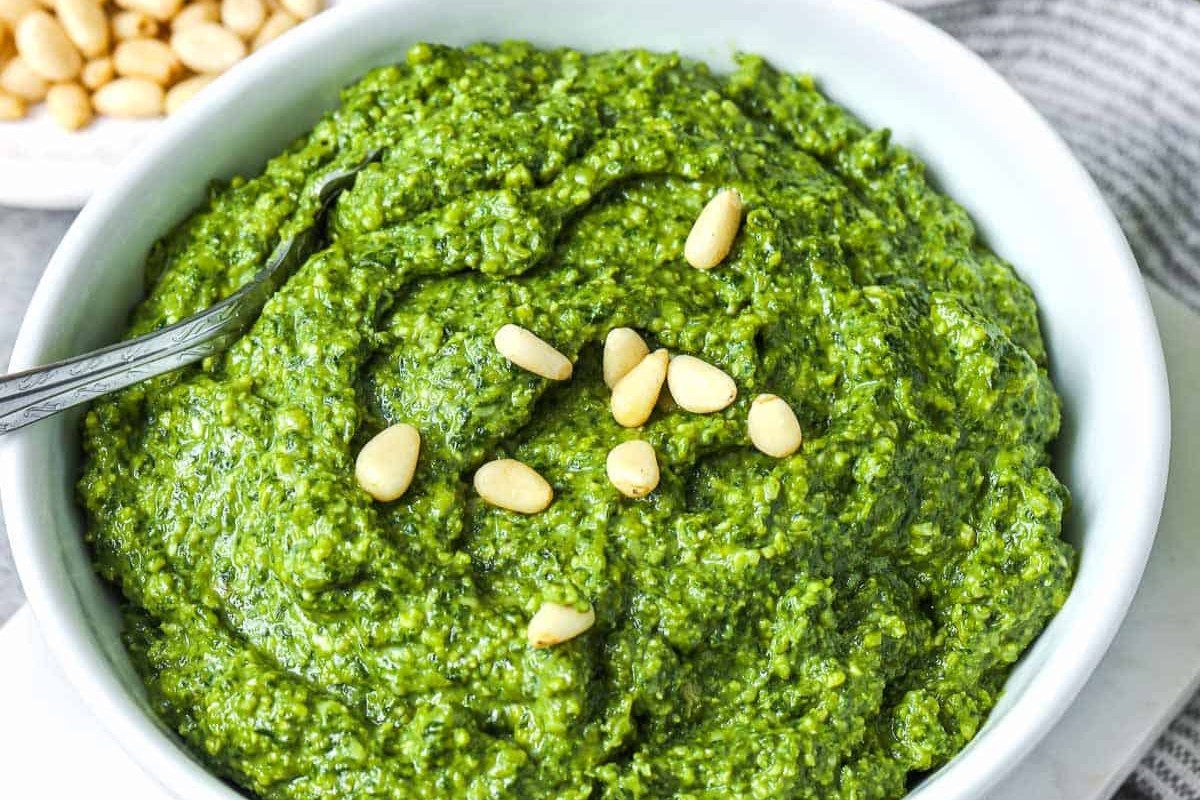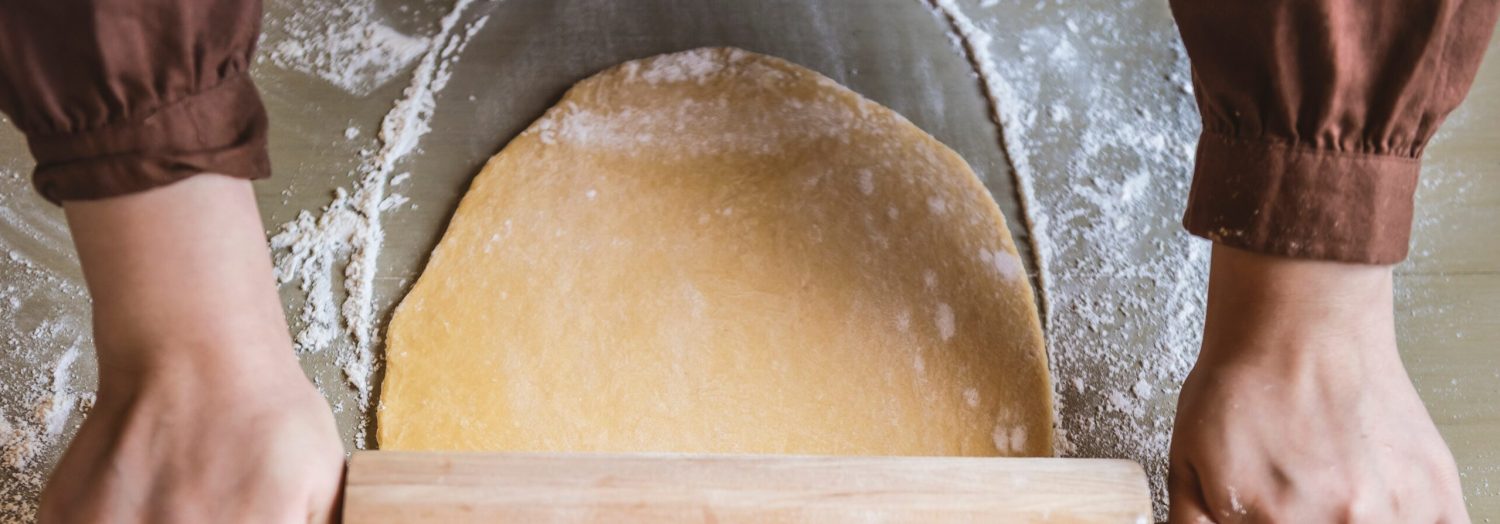This fresh basil pesto recipe is a delightful blend of aromatic basil leaves, rich parmesan cheese, and nutty pine nuts. Perfect for pasta, sandwiches, or as a dip, this versatile sauce brings a burst of flavor to any dish.
While most of the ingredients for this recipe are common, you might need to pay special attention to pine nuts. These small, buttery nuts can sometimes be found in the baking or snack aisle of your supermarket. Additionally, ensure you get fresh basil leaves for the best flavor.

Ingredients For Fresh Basil Pesto Recipe
Basil leaves: Fresh and aromatic, these leaves are the star of the pesto, providing a vibrant green color and a distinct flavor.
Parmesan cheese: Adds a rich, salty taste that complements the basil perfectly.
Olive oil: Extra virgin olive oil is preferred for its smooth texture and fruity flavor.
Pine nuts: These small, buttery nuts add a subtle nutty flavor and creamy texture to the pesto.
Garlic: Fresh minced garlic gives the pesto a pungent kick.
Salt: Enhances the overall flavor of the pesto.
Black pepper: Adds a hint of spice and depth to the sauce.
Technique Tip for This Recipe
To achieve a smoother texture in your pesto, make sure to toast the pine nuts lightly before adding them to the food processor. This not only enhances their flavor but also helps them blend more easily with the basil leaves and garlic. Additionally, when adding the olive oil, pour it in a slow, steady stream to ensure it emulsifies properly, resulting in a creamy and cohesive sauce.
Suggested Side Dishes
Alternative Ingredients
fresh basil leaves - Substitute with spinach leaves: Spinach provides a similar texture and mild flavor, though it lacks the distinct aroma of basil.
fresh basil leaves - Substitute with arugula: Arugula offers a peppery taste that can add a unique twist to the pesto.
grated parmesan cheese - Substitute with pecorino romano: Pecorino Romano is a bit saltier and sharper, but it complements the pesto well.
grated parmesan cheese - Substitute with nutritional yeast: Nutritional yeast provides a cheesy flavor and is a great vegan alternative.
extra virgin olive oil - Substitute with avocado oil: Avocado oil has a mild flavor and similar healthy fats, making it a good alternative.
extra virgin olive oil - Substitute with grapeseed oil: Grapeseed oil is neutral in flavor and works well in pesto.
pine nuts - Substitute with walnuts: Walnuts offer a similar texture and a slightly earthy flavor.
pine nuts - Substitute with almonds: Almonds provide a mild, nutty flavor that works well in pesto.
minced garlic - Substitute with garlic powder: Garlic powder can be used in a pinch, though fresh garlic offers a more robust flavor.
minced garlic - Substitute with shallots: Shallots provide a milder, sweeter flavor that can add depth to the pesto.
salt - Substitute with soy sauce: Soy sauce can add a salty and umami flavor, though use sparingly to avoid overpowering the pesto.
black pepper - Substitute with white pepper: White pepper offers a similar heat but with a slightly different flavor profile.
Alternative Recipes Similar to This Dish
How to Store or Freeze This Recipe
- To keep your fresh basil pesto vibrant and delicious, store it in an airtight container. Drizzle a thin layer of olive oil on top to prevent oxidation.
- For short-term storage, place the container in the refrigerator. Your pesto will stay fresh for up to a week.
- For longer storage, freezing is your best bet. Spoon the pesto into an ice cube tray, filling each compartment. Freeze until solid, then transfer the pesto cubes to a resealable plastic bag or airtight container.
- When you're ready to use, simply pop out the desired number of pesto cubes and let them thaw in the refrigerator or at room temperature.
- If you prefer, you can also freeze the pesto in small, resealable plastic bags. Flatten the bags for easier storage and quicker thawing.
- Remember, pesto can darken over time due to exposure to air. To maintain its bright green color, always cover it with a layer of olive oil before sealing.
- Avoid reheating pesto directly on the stove or in the microwave, as this can alter its fresh flavor. Instead, let it come to room temperature naturally or stir it into hot pasta or soups to gently warm it.
How to Reheat Leftovers
Gently warm the pesto in a small saucepan over low heat. Stir constantly to prevent the olive oil from separating or the basil from losing its vibrant green color.
For a quick and easy method, place the pesto in a microwave-safe bowl. Cover it loosely with a microwave-safe lid or plastic wrap. Heat on low power in 15-second intervals, stirring in between, until it reaches the desired temperature.
If you prefer a more hands-off approach, place the pesto in a heatproof bowl and set it over a pot of simmering water (double boiler method). Stir occasionally until warmed through.
To reheat pesto for pasta, add the pesto directly to the hot, freshly cooked pasta. The residual heat from the pasta will warm the pesto without the need for additional cooking.
If you have frozen pesto, thaw it in the refrigerator overnight. Once thawed, use any of the above methods to gently reheat it.
Best Tools for Making This Recipe
Food processor: Essential for finely chopping and blending the basil leaves, pine nuts, and garlic to create a smooth pesto.
Rubber spatula: Useful for scraping down the sides of the food processor to ensure all ingredients are evenly mixed.
Measuring cups: Necessary for accurately measuring the basil leaves, parmesan cheese, olive oil, and pine nuts.
Measuring spoons: Needed to measure the salt and pepper precisely.
Knife: Used for mincing the garlic cloves before adding them to the food processor.
Cutting board: Provides a stable surface for mincing the garlic and preparing other ingredients.
Mixing bowl: Used to transfer and store the pesto once it is made.
Plastic wrap: Helps cover the mixing bowl to keep the pesto fresh until ready to use.
How to Save Time on This Recipe
Pre-measure ingredients: Measure out basil leaves, parmesan cheese, olive oil, pine nuts, and garlic before starting.
Use pre-minced garlic: Save time by using store-bought minced garlic instead of mincing fresh cloves.
Toast pine nuts in bulk: Toast a large batch of pine nuts and store them for future use.
Batch process: Make a larger quantity of pesto and freeze portions for later.
Food processor efficiency: Ensure your food processor is clean and ready to go before starting.

Fresh Basil Pesto Recipe
Ingredients
Main Ingredients
- 2 cups fresh basil leaves
- ½ cup grated Parmesan cheese
- ½ cup extra virgin olive oil
- ⅓ cup pine nuts
- 3 cloves garlic minced
- ¼ teaspoon salt
- ¼ teaspoon black pepper
Instructions
- Combine basil leaves, pine nuts, and garlic in a food processor and pulse until coarsely chopped.
- Add Parmesan cheese and pulse a few times more.
- Slowly add olive oil in a constant stream while the food processor is on. Stop to scrape down the sides with a rubber spatula.
- Add salt and pepper to taste.
- Transfer the pesto to a bowl and cover with plastic wrap until ready to use.
Nutritional Value
Keywords
More Amazing Recipes to Try 🙂
- Low Country Boil Recipe1 Hours
- Gluten-Free Vegan Banana Bread Muffins Recipe40 Minutes
- Carrot Pineapple Cake Recipe1 Hours
- Strawberry Salad Recipe15 Minutes
- Greekhouse Dressing Recipe10 Minutes
- Keto and Vegan Chocolate Almond Balls Recipe10 Minutes
- Gluten-Free Mascarpone Pound Cake Recipe1 Hours 15 Minutes
- Parmesan Garlic Keto Chicken Wings Recipe40 Minutes

Leave a Reply